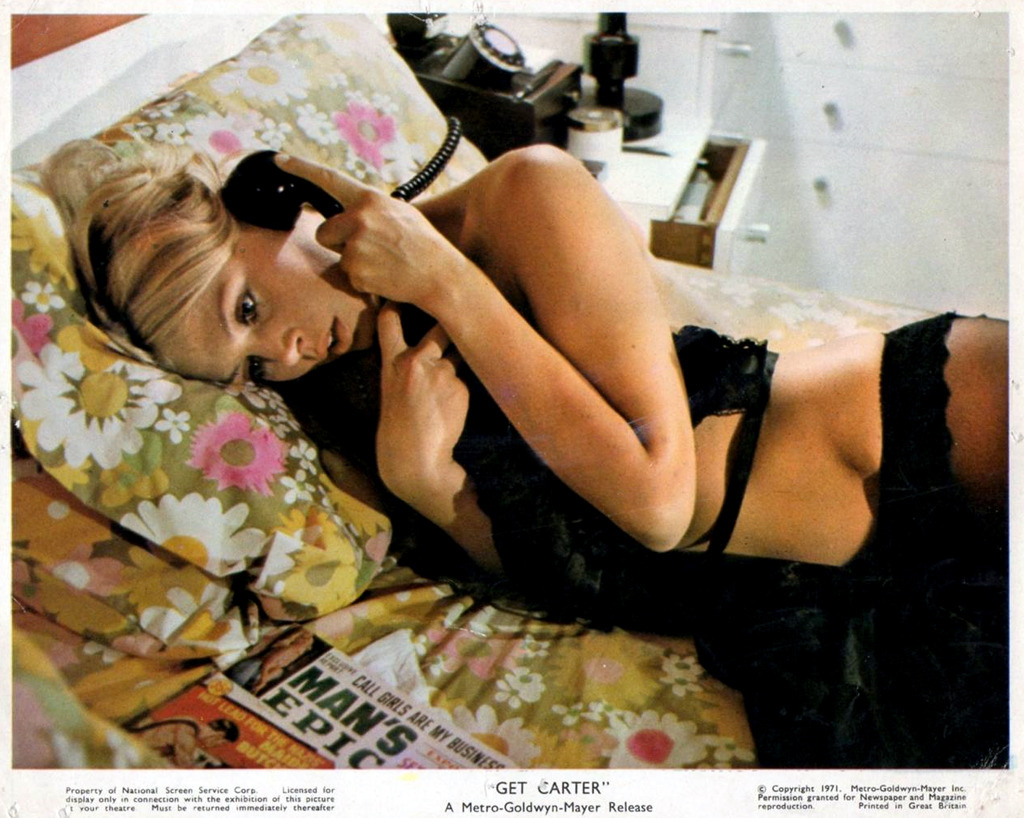 |
| Michael Caine' gone a'hunting. Better run and hide. |
“You know, I'd almost forgotten what your eyes looked like. Still the same. Pissholes in the snow."
1) Anybody who thinks of Michael Caine as a soft actor who plays variations of himself needs to see this performance. Rarely smiling, struggling to control a seething rage within, Caine is a veritable Angel of Death come a’calling. His ice cold performance holds the film together by sheer force of will.
2) Looking at it now, there’s a strange sadness in the interactions between Caine and Ian Hendry’s Eric. Seeing both men, who were in the throes of alcoholism at the time, and knowing that Hendry’s life was close to ending because of it makes their scenes feel different than director Mike Hodge intended.
3) Even though she’s not the best of the handful of women in the film (none of which really has enough screen time to justify being called the female lead), Britt Eklund’s Anna does take the thankless job of being the sexual plaything/’fiance’ of Caine’s Carter and makes the best of it. Her performance, along with the one she gives in The Wicker Man, does add to my suspicion that there was a genuine actress buried in that sex symbol wrapping of hers.
4) If I had to choose a favorite of the number women Carter has his way with, I’d have to go with Dorothy White’s Margaret. Maybe because she’s a ginger, maybe it’s because of her pronounced accent, maybe it’s because of that one scene in the car where she couches Carter’s situation in fairy tale language (‘You’re going to meet the Demon Lord’), but she’s wickedly cool, eminently watchable and sexy as all Hell. And because of how Hodges presents her to us, her final fate--something that throws Carter’s behavior towards her in the later second act in question--is truly shocking.
| Michael Caine is naked, and he still is going to kick your lilly white ass! |
5) Hodges’ directorial style is very distinctive, particularly when it comes to action scenes. Frequently, he will cut to an overhead long shot so we can see different planes of action. It’s an interesting choice which distances us from what’s going on in the shot while also giving us a great deal of comprehension as to what is happening. In the day of getting too close when it comes to fight scenes in an effort to ‘get the viewer into the action,’ this method actually makes the action much more comprehensible.
6) ...although it should be mentioned how violence, when it comes, does so shockingly and very, very suddenly. Even though Hodges doesn’t engage in smash cuts and other tricks that are used in modern filmmaking, the sudden changes narratively from the slow, deliberate pace of most of the story and the abrupt way the violence intrudes upon it--as if the brutality invades the film from the movie playing on the screen next door--unhinges the viewer and disorients them.
7) This is yet another film I don’t think could have been made today (although it does make me curious as to how botched the Sylvester Stallone, Seattle-set version was). Beyond a certain point, particularly when we are introduced to the concept of ‘L’--it’s hard to call him an actual character--there is a sense of inevitability to Carter’s journey and where it will end up. And even though we sort of understand what Carter’s fate ultimately be, it still ends up as a shock when it happens.
 |
| Michaek Caine is so hardcore he gets Britt Ecklund off with phonesex...before phonesex was even invented! |
8) There is one wordless scene where we learn why Carter’s brother had to die that is magnificent. Primarily focused on Caine sitting on a bed, it’s a magnificent moment because he retains that weird stoicism, his facial expression never changing--and yet we can feel the white hot rage building up in Carter.
9) The cinematography here is interested, especially in the way everything seems designed to make Carter look separate from everyone else in Newcastle proper. The simple choice of giving Carter a black trenchcoat that makes him pop out from the amongst the uniformly grey and drab background works. It emphasizes that Carter has become something apart from the city he grew up in and at certain key action moments he comes off as the Angel of Death stalking these grimy little streets.
| Michael Caine just caught you looking at him funny...RUN! |
10) Hodges really seems to love these sequences where he transposes the main action with something else. Most of them are the expected ‘here’s the normal life, and here’s the shit Carter’s knee deep in,’ but there’s this one moment where he intercuts between Carter being ridden towards a meeting and the sex he’s going to have with the driver later that’s really striking and peculiar. It’s the sort of playing with time and space that future directors like Tarantino and Soderberg will embrace that I wish would happen more often.
Overall...a brutal and brilliant crime film that’s as dark as the soul of its protaganist, and evidence that Michael Caine was, and always will be, hardcore.
I've got to catch this one again; I remember loving it. (Nerd Note: Alan Moore uses Carter as an important supporting character in his League of Extraordinary Gentlemen: 1969 adventure.)
ReplyDeleteBTW:
Dear Thomas,
In recognition of your awesomeness, it is my pleasure to bestow upon your blog The Liebster Award!
(please scroll down in my post for an explanation; thank you!)
http://lernerinternational.blogspot.com/2013/05/in-praise-of-jack-kirby-and-weve-been.html
—Ivan